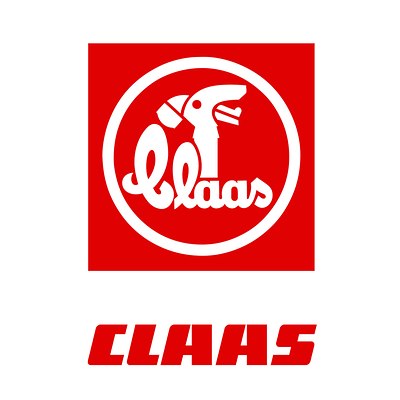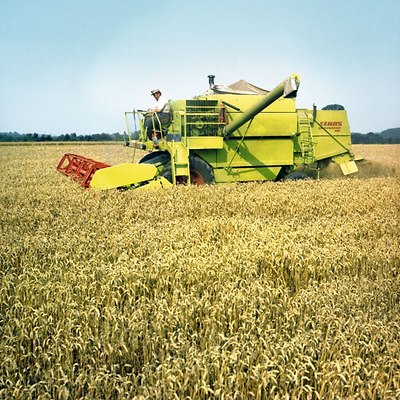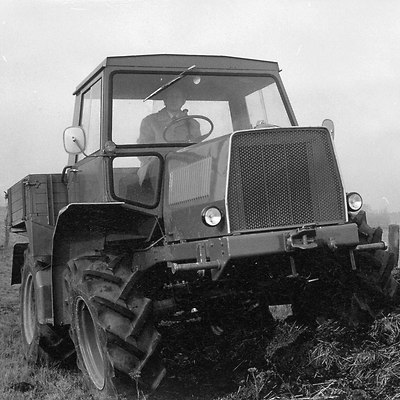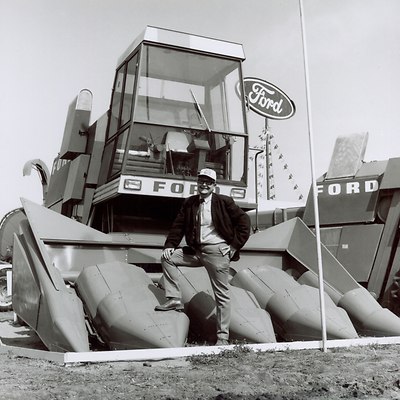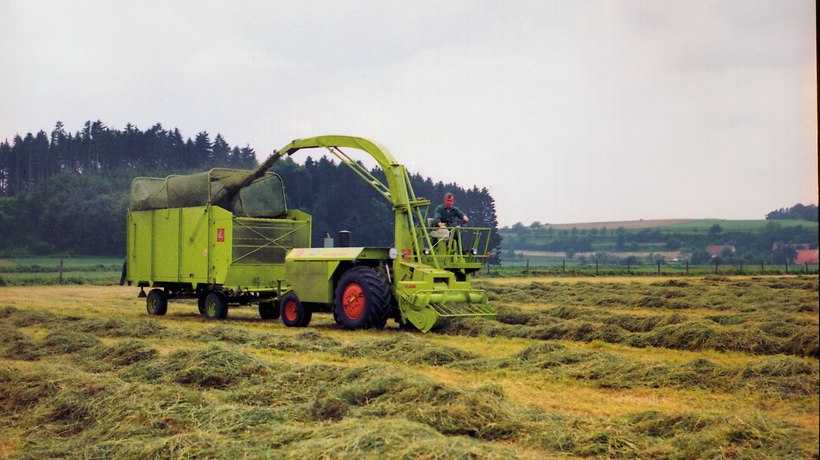

CLAAS – the harvesting specialist
In the years of the German “economic miracle” after the Second World War, CLAAS had accomplished an almost meteoric rise to become one of the world’s leading combine harvester manufacturers. Eventually, however, the economic boom came to an end, and the demand for agricultural machinery rapidly declined. In response to the new situation, the firm underwent a comprehensive modernisation and strategic realignment programme. With the purchase of the Bautz and Speiser firms, CLAAS widened its product range, and successfully negotiated the transition from “combine harvester specialist” to broad-based “harvesting specialist”.
The transformation in the company’s profile was reflected in its corporate design: in 1966, CLAAS introduced a new company logo and the “seed-green” colour that is now synonymous with its machines.
The late 1960s were years of economic, political and social transformation – and big changes were happening in the agricultural sector as well. After the heady years of farms taking up agricultural technology for the first time, towards the end of the 1960s, there was a marked cooling off in the market, based on a profound structural transformation taking place in farming.
“Grow or perish” was the often-heard slogan at the time – and it was just as applicable to agricultural machinery manufacturers as it was to farmers. As a result, numerous machinery producers, including some big names in the sector, threw in the towel and left the industry for good. In the 1970/71 year, combine harvester unit sales in Germany were just 54 percent of the prior year figure.
This new situation also brought far-reaching changes for CLAAS, and prompted a rethink of the firm’s future strategy. In retrospect, however, what many saw as a crisis threatening the company’s very existence in fact provided the necessary momentum for a comprehensive modernisation programme – precisely what was needed after a period of meteoric growth. In fact, CLAAS emerged from the crisis in the agricultural machinery sector with a whole raft of innovative, forward-looking products. The turbulence in the marketplace forced CLAAS to rethink the niche strategy it had been following, focused solely on the combine harvester.
Entry into the forage harvesting sector
With its purchase of the Bautz and Speiser firms, CLAAS expanded its product range at a stroke to include mowers, tedders, swathers, self-propelled forage wagons and forage harvesters.
The most obvious course of action was to resume activity in the baler sector, where the name of CLAAS was still held in high regard amongst its customers. After careful consideration of the available locations, in autumn 1961, it was decided to set up a new production plant in the French district of Lorraine, as a greenfield construction project. Before long, the firm had again caught up with the European leaders in the sector.
With the return to baler production, the company could be said to already have a footing in the forage harvesting segment. However, the real entry to this sector was achieved with the purchase of the Bautz firm, based in Saulgau, in 1969. Alfred and Eugen Bautz, as managing partners of the old and highly regarded family firm, and friends of CLAAS founder August Claas, were having difficulties in finding a suitable successor for their business. Bautz had a long and honourable tradition, and extensive experience in the forage harvesting sector, based on its location right in the heart of a region of intensive grassland farming and highly efficient dairy farms. Accordingly, forage harvesting know-how was deeply embedded in the fabric of the Bautz business. With this acquisition, CLAAS gained a broad range of mowers, tedders, swathers and self-propelled forage wagons.
The next step towards a wider product range was taken with the purchase of the renowned Hermann Speiser agricultural machinery producer from Göppingen, which also had a friendly relationship with CLAAS. When Speiser expressed a wish to sell off its forage harvester production operation, CLAAS took the initiative and promptly added “forage harvester technology” to its Saulgau-based product range. Maize as a chopped forage crop was not widely used at that time. Yet the value of the JAGUAR product name, also acquired from Speiser in the takeover, was to prove a valuable asset in later years.
Already in 1972, CLAAS began work on developing a self-propelled forage harvester, in view of the growing interest in the marketplace, and spurred on by the machines that some dealers had managed to construct. Its experience in the construction of self-propelled combine harvesters and proven components from the large-scale series production of combine harvesters enabled the development time to be significantly reduced, so that the firm unveiled its first self-propelled forage harvester, the JAGUAR 60 SF, as early as 1973. With the upgraded JAGUAR model series, the firm quickly became the European market leader, and ultimately – with the 800 model series – the world market leader.
The acquisition of silage harvesting technology can be seen as completing the process of the build-up of CLAAS forage harvesting know-how. The firm now covered both the grain and forage harvesting segments, with a single, broad-based product range. The one-time combine harvester specialist had become “CLAAS – the harvesting specialist”.
Scaling up to a whole new dimension
One combine harvester for all the world’s crop fields – the DOMINATOR 80 was the first model of this famous combine harvester series.
Yet the combine harvester still remained part of the picture, as the firm’s “bread and butter” machine, which it could not afford to neglect through the years of increased diversification. The progressive transition from trailed to self-propelled machines in the European market had largely been completed by the end of the 1960s, so that the legendary SUPER machine had now had its day. The trailed machines owned by the great majority of farmers were increasingly being replaced by small self-propelled machines at prices below DM 10,000.
The move to self-propelled machines also marked a trend towards collaboration between neighbouring farms, machine ownership collectives and contract threshers, and therefore towards ever-higher-capacity machines, more powerful engines, wider mowers and larger grain tanks. CLAAS responded to this transformation in the agricultural sector with a completely new development initiative, called “Project 12”, but better known as the DOMINATOR.
The DOMINATOR, which went into harvesting operation for the first time in the summer of 1970, was developed within an incredibly short period of time, applying the “simultaneous engineering” concept, where development and production take place almost at the same time. With the DOMINATOR, CLAAS set new standards in international combine harvester construction. The new modular construction allowed greater rationalisation, resulting in significant cost savings in the manufacturing operation and lower inventory numbers.
The new combine harvester was also an outstanding performer in the field. During the ensuing years, the DOMINATOR became the top-selling combine harvester model in Europe, thanks to its outstanding productivity, reliability and “multi-crop” capability. In the 1983/84 financial year, the company passed the billion DM sales revenue milestone for the first time.
The task now was to retain that leadership position. This was achieved with the new CS model, in which the straw walkers were replaced with a “cylinder system” (CS) with eight separating cylinders. The new system was first introduced in 1981 in the DOMINATOR 116 CS. In 1993, throughput was further boosted by up to 30 percent with the introduction of the MEGA threshing system with upstream accelerator drum. The DOMINATOR remained the cornerstone of the CLAAS combine harvester range for more than two decades.
A CLAAS tractor?
CLAAS engineers had spent the four years from 1968 to 1972 making subtle modifications to a CLAAS HSG tractor model, to be distributed in collaboration with Daimler-Benz and manufactured by CLAAS.
The new product strategy was clearly going to include a place for the most important machine of all in the agricultural sector: the tractor. August Claas had already developed and marketed a tractor-like “carrier for a range of tools and implements” in the late 1950s, called the “HUCKEPACK”. It was designed for use all year round, as the ultimate “all-purpose” machine, but it remained in production for only a short time.
However, CLAAS had never given up completely on the tractor concept, and, at the end of the 1960s, it returned to the idea with the HSG project. The HSG was initially intended as an experimental vehicle for the development of a new hydrostatic transmission for combine harvesters (“Hydrostatisches Getriebe” in German, hence the abbreviation HSG), but it soon morphed into a project in its own right, as an entry ticket into the high-end tractor segment.
CLAAS engineers had spent the four years from 1968 to 1972 making subtle modifications to a CLAAS tractor model, to be distributed in collaboration with Daimler-Benz and manufactured by CLAAS. However, the partnership did not proceed, and, as part of a savings programme at the time, the project had to be put on ice. Yet the dream of a CLAAS tractor remained. In retrospect, the HSG can be seen as marking the beginning of the development of trac vehicles at CLAAS, an idea that was taken up again in 1978 with Project 207, successfully introduced onto the market many years later as the XERION large tractor series.
New distribution channels
From 1965, CLAAS joined forces with Ford Tractors Operations in an effort to gain a footing in the world’s biggest retail market, the USA.
The fundamental changes introduced during this time of transition extended beyond the product range as such. CLAAS had been an export-focused business right from the outset, and over the years it had built up an enviable reputation abroad with an excellent dealership and service network. This successful strategy was now to be replicated in further markets.
Within Europe, in countries such as Spain and Italy, CLAAS had worked successfully since the 1950s with local importers. This distribution structure was now overhauled, with the establishment of the firm’s own distribution companies, CLAAS Iberica and CLAAS Italia, in 1969 and 1973, respectively.
CLAAS was also doing well in Hungary, as the only western agricultural machinery manufacturer with a presence in the socialist country’s market, since as early as 1969. Its importer was a state trade corporation, Agrotec. The first major customer was IKR, a large state-operated farming enterprise, which subsequently also obtained an import permit. CLAAS sold a total of around 5,000 large combine harvesters in Hungary up until the transition in 1989. The excellent reputation that CLAAS now has in Hungary is ultimately attributable to the firm’s presence over many years in the former eastern bloc countries.
It also had important export markets in North Africa. Smaller combine harvesters, and especially the new baler models, were in high demand in countries such as Algeria, Morocco, Tunisia and Libya. In some cases, obtaining an export permit depended on setting up a local production operation. A licence agreement was therefore signed with Algeria in 1975 for the production of the MERCATOR combine harvester and the MARKANT baler.
From 1965, CLAAS joined forces with Ford Tractor Operations in an effort to gain a footing in the world’s biggest retail market, the USA. The company succeeded in obtaining the distribution rights for CLAAS combine harvesters in the entire North American market, and since then these machines have been sold under the Ford name, in blue and white colours, in the USA, Canada and subsequently also in Mexico. To boost sales in this market, in 1979, CLAAS also established its own marketing and distribution company, CLAAS of America Inc. (CoA). When the partnership with Ford came to an end in the mid-1980s, and a later agreement with Massey Ferguson was also terminated, the US subsidiary took over the main responsibility for CLAAS exports to North America.
Focus on globalisation
These expansions in the distribution structure were indicative of a trend towards an increasingly international focus in the company’s strategy. After successfully negotiating the turbulent transition phase in the 1970s, with the benefits of a new organisational structure and an expanded distribution operation, attention switched back to the company’s core competence: harvesting. In order to remain competitive in the international arena, much faster and stronger growth in this sector was a key priority, and indeed essential for the company’s ongoing success. A new opportunity to achieve this opened up with the political transition from 1989, providing access to new markets in the former eastern bloc states.


